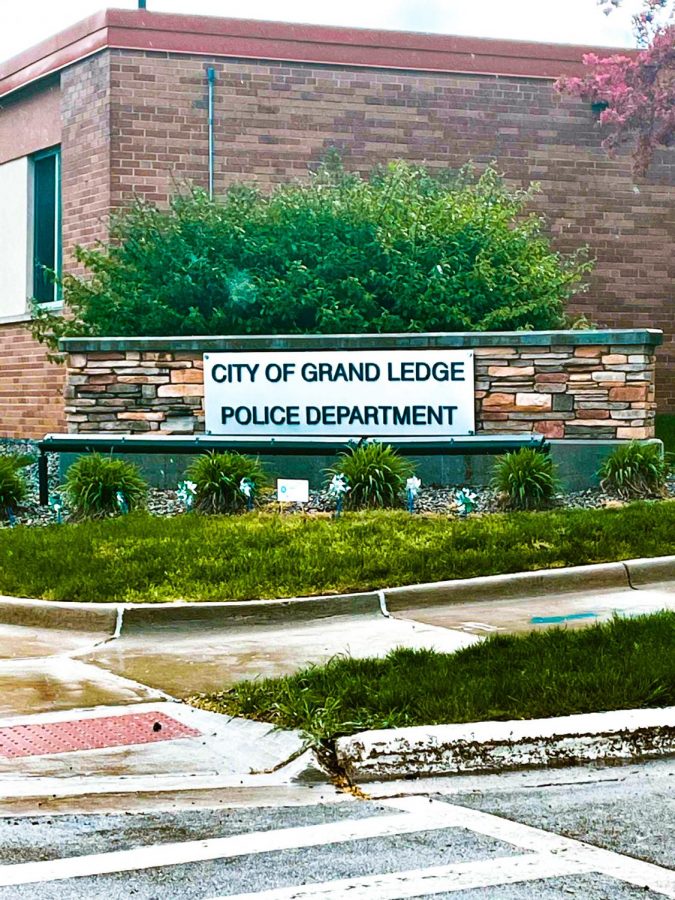Do Police Need More Training?
The Grand Ledge Police Department is located right in the heart of downtown Grand Ledge.
May 13, 2021
With recent police brutality cases, people have been wondering if training would solve the issue or not. In past months, multiple cases have been released to the public where police have used excessive force, or unjustly killed civilians.
The training that police officers do go through varies in length and intensity based on the specific state and agency they complete their training at, as well as the specific position they are assigned. The absolute minimum amount of training hours completed is 594 hours. If field training is not included, most basic training programs last around 840 hours or 21 weeks. That is just over 4 months. After the initial training in the academy, graduates are required to pass an examination given by the state. This includes a physical fitness test, a reading and writing test, along with a drug test.
Training is a huge component in becoming an officer, but experience holds a greater impact over additional training. April 11, 2021, Duante Wright was shot and killed by police officer, Kimberly Potter, at a traffic stop for expired tags. During the interaction, officers discovered that Wright had a warrant out for his arrest. Wright made an effort to get back into his car while officers were attempting to detain him, prompting a brief struggle. Potter proceeded to pull out her gun, and yelled “taser, taser, taser.” Seconds later, a shot was fired and Wright tried to flee the scene. Soon, Officer Potter knew she had shot this man. Wright managed to drive several blocks down the road, colliding with another vehicle, before the car came to a complete stop. Wright was pronounced dead on scene.
Many of the officers in recent police brutality cases have been in the force for several years. With this being said, veteran officers have the knowledge and capability to react properly in situations. Officer Potter of the Duante Wright case had been in the force for 26 years prior to the incident and was in the process of training a rookie officer. Along with Potter, Officer Robert Bates had years of experience before mistaking his gun for a taser. These officers, and many more, have already undergone training for these specific situations, and by their experience, additional training would not be necessary. This is due to constantly being put under pressure and knowing how to make correct decisions on the spot.
Police do not need additional training to know the difference between the two. Musicians know exactly where each key or string is on their instrument just by practicing it over and over for years. A standard taser weighs about 8 ounces and a standard glock weighs just over 2 pounds. Just by the weight, officers should be able to distinguish a difference. There are more differences like colors and safety location. Also, items on a police belt are placed in specific spots to limit the amount of accidental discharge of the wrong weapon.
“It is standard practice for officers to carry less lethal weapons near their non-dominant hand and their service weapons near their dominant hands.” (Law and Crime)
Officers go through specific training for weapons on their belt. In order to draw a taser, an officer has to reach across the body to their non-dominant side. Police officers have to be confident on where each item is located on their belt. Veteran officers should be especially confident in these locations. The recent outbreaks in police brutality cases have been from veteran officers. Their experience and knowledge is enough to prevent these incidents from happening.
In an interview with a police officer of twenty-two years, the question was asked if he felt that police that have been in the force for several years should know exactly where each item on their belt is located.
“Whether you have been a police officer for multiple years or are new to the profession it is important to be comfortable and competent in the use of equipment that is issued and will be used in the course of regular police duties. Continued training, including scenario-based, stress-inducing training, is conducted with officers in order to simulate real-world incidents that officers will encounter.” said Detective Mike.
With police brutality cases such as the Adam Toledo case, it is clear that the officer, Eric Stillman, was not prepared to be in that situation where he was required to make a stress-induced call, and that decision resulted in the death of thirteen-year-old Adam Toledo. The officer made a split-second decision to fire a shot, without noticing that Toledo had dropped the gun he was previously holding. If that officer had waited just a few more seconds, he would have seen that Adam had both of his hands up in surrender. Situations like this are unacceptable. A thirteen-year-old was shot and killed because an officer got nervous and shot instead of better analyzing the situation. More training for stress-induced decisions would mean fewer cases such as this one in the future. Fewer kids being shot.
While becoming a police officer is a five-month feat, lawyers spend upwards of seven years learning the law, and they don’t hold guns in their belts. A four to six-month training period is not sufficient enough to be trusted to be accountable for someone else’s life. This is a profession where a mistake takes someone’s life. A simple mix-up causes a mother to lose her son, a husband to lose his wife. Mistakes are not acceptable when someones’ life is at stake.
“Police Experts and persons who consult for police agencies seem to universally agree that increased police training in areas such as Persons Experiencing Mental Health Crisis and Intervention and De-escalation techniques will assist in bringing more potentially violent situations to a peaceful resolution with minimal use of force on the part of the police.” said Detective Mike.
To become a surgeon, there are approximately eleven to fourteen years of training involved to climb up to the highest level and be responsible for other people’s lives on a weekly basis. Mistakes in either of these professions can cost someone their life, which is the reason for the extensive training doctors and surgeons go through. There needs to be more extensive training requirements for police officers. This would assist officers in holding more confidence when out on calls, as well as the likelihood of mistakes drops significantly the more training is done. When they get something wrong someone could die. Police officers need to be held to a higher standard, and that starts with better training.
While these types of mistakes are absolutely unacceptable, split-second decisions cannot be easy, especially when someone is under immense pressure. Hopefully, these officers that caused these deaths will be held accountable, even if they were accidental killings. More training in these situations could solve this problem.
There is no way to tell when and if police brutality cases will end. Do officers need more training or is their experience enough? Police officers hold a high standard above their heads and are responsible for the lives of others.



